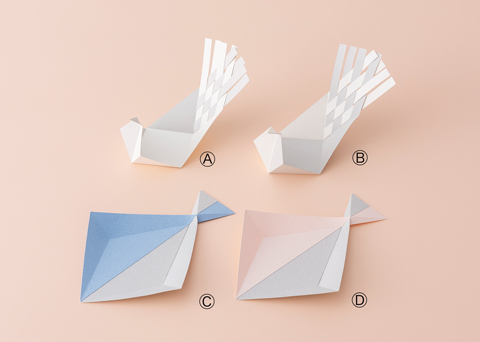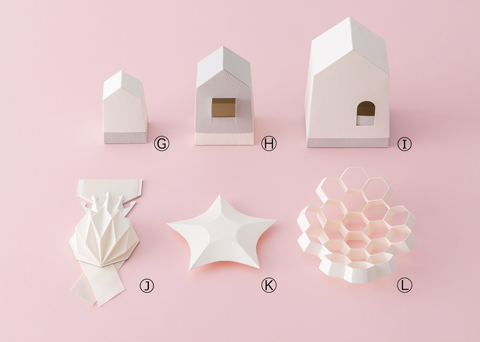
A single piece of paper cut, bent, and fastened together to create expressive shapes that make use of the unique characteristics of different papers. Paper crafts are one of the most popular arts, and Japan has garnered a great deal of attention around the world as a country with a highly evolved paper crafting tradition.
Yasuyuki Wada is a paper craft artist who uses papers of different textures and colors to create singularly realistic animals. Made from a single sheet of paper, these dynamic animal crafts overflow with warm charm, fascinating young and old alike.

Paper Craft Artist
Yasuyuki Wada
Born in 1982 in Osaka Prefecture. Lives in Chiba Prefecture. Graduated in 2006 from the Department of Product Design, Kobe Design University and in 2008 from the Graduate School of Arts and Design, Kobe Design University. His professional artistic debut came with a collaborative exhibition with illustrator Junzo Terada. In addition to creating work for magazines, Wada is active in a wide range of media, including exhibitions, workshops, and television appearances. Since 2014, he has designed products for the paper craft kit brand gu-pa.
Official website: www.injan.net
“Making three-dimensional animals from a flat sheet gives the paper a whole new quality.”

Yamatani Standing Paper Zoo (2011-2012)
A miniature zoo kit featuring 20 different animal figures and a natural diorama. In addition to those pictured, the kit includes such popular animals as elephants, lions, koalas, and alpacas.
I started doing paper crafts when I was a student in art school. I had planned an exhibition and workshop for elementary school students and created paper crafts of traditional Japanese school bags for display. I saw the expressions on the kids’ faces when they saw my work and watched them become totally engrossed in folding paper, and I knew then I wanted to do something that conveys the joy of making things.
For my graduation project, I created a paper craft picture book that helps readers learn about insects while shaping them from paper. After undergrad, I went on to grad school and devoted myself to designing and creating paper crafts. I’ve been creating objects with animal motifs ever since. In the beginning, I would throw objects away when I couldn’t make them work, but I began feeling guilty about crumbling up and throwing away animals once they had taken a three-dimensional shape. Flat sheets of paper that would come to form animals seemed to me to have a life, and I became even more captivated when I realized how amazing it is that creating paper animals gives the paper a whole new quality.
After grad school, I gave myself two years to make a living as an artist and worked hard to sell my work, mostly to design offices. At the time, I was living in Kansai, in western Japan, but I would visit Tokyo where more experienced paper craft artists were getting a lot of work. They gave me valuable advice. After that, orders for my paper crafts gradually increased, and I had the opportunity to appear on TV. I became more confident that I would be able to make a living as an artist. It was then that I decided to move to the Kanto area (around Tokyo) to find even more substantial work.

head box (2014)
gu-pa’s original foray into paper craft kit products. Ideal for interior accents, these animal heads are designed in box shapes for unique gift wrapping, as well. Includes a total of five animals—hippo, deer, elephant, rabbit, and bear.

Animal Nose Masks
A paper craft set that reproduces the distinctive noses of animals. Popular at children’s workshops and other events, the nose masks come together using only tab inserts and requiring no glue. Includes a total of six animals—pig, elephant, rabbit, lion, walrus, and wolf.
How Wada Works

1. After determining the animal for the motif and the paper he will use, Wada then collects images of the animal photographed from different angles. Depending on the item, he may make sketches to get a clearer picture of the final work.
2. Aligning images for the front, side, and other views, Wada cuts and fastens together copy paper to create a prototype for the three-dimensional work. He uses a stylus to form creases and paper glue to keep the shape, evaluating the overall form for strength and specific gravity balance and making fine adjustments so that the animal stands stably on its own.
3. Using this prototype, Wada develops the paper pattern using a plotter. He makes the adjustments needed for assembly, adding part joints and overlap margins for glue.
4. Wada orders the steps for assembling the animal and writes instructions with illustrations for reference. If the work will be sold to consumers, it is finished with Thomson type punching processing and laser cutting. It takes approximately five months to turn his original idea into the end product.
Motifs based on the qualities of different papers to create realistic animals
A few years after I started working as an artist, an editor who had seen my work got in touch, and we published a book. The theme was paper boxes and containers, and the book featured 25 different paper crafts with instructions for how to make them.
This was a great opportunity to re-experience paper, to enjoy it in practical ways and bring the fun of creating and the joy of paper to everyday life. After the book, I invited Fukunaga Print Co., Ltd. (Tachikawa City, Tokyo) to my solo exhibition, and this led to a collaborative project with them. Fukunaga Print Co., Ltd. has produced many paper products that combine the company’s printing and processing technology with designers’ ideas. Together, we launched a line of paper craft kits.
One of these, Top to Tail, is a series of kits for assembling realistic animals with body parts that move. For true realism, we choose paper with qualities that are close to the actual feel and look of the animal’s skin and coat. We use Croco GA, for example, which is an embossed paper with a bumpy texture like crocodile skin, to create the crocodile. Sometimes, I look at a certain type of paper and imagine what I could make, taking inspiration for the animal from the paper itself. I often use a fine paper called Mermaid for my work. I like it, because it is just stiff enough to be easy to work with and comes in a wide variety of colors with a slightly cushiony texture that feels soft. Next, I’d like to try creating objects that combine different materials, like thread, yarn and other fabrics, with paper.

Gemstone Boxes (A –E in photo: crystal, emerald, sapphire, and ruby) and Diamond Box (F). The lid and bottom of the gemstone boxes are assembled separately to pull apart and can be used to hold small items or as a gift box.

The Striped Bowl (A) and Small Adjoining Boxes (B & C) are assembled by fastening together multiple identical parts. The Hydrangea Boxes (D & E) are made of clusters of square pyramid, and the petals can be closed to form a gift box.
Hoping to help children see the fun of making things

One of my goals is to open a workshop studio for kids. There used to be many magazines that included paper craft kits at the back, but now most of the paper crafts we see are already made. There even seem to be fewer and fewer of these magazines so, outside of arts and crafts classes at school, kids have fewer opportunities to use paper.
Paper is a very familiar, easy-to-use material. I want children to have the chance to use their own hands to turn a flat sheet of paper into a three-dimensional object and to experience the fun, the sense of achievement, and the excitement that comes with making something from scratch. It would be great if my work gave them that chance. I am currently working on a new kit for the paper craft kit series sold by Fukunaga Print. People around the world love animals, and this motif has universal appeal. I would like to continue making classic paper toys that don’t go in and out of style, toys that will be loved by children around the world for years to come.

The Braided Bird Plates (A & B) and Fish Plates (C & D) take their inspiration from these creatures. Use them as an accent around the house or as tableware in the dining room.

House Boxes (A, B, & C) are created in two parts with lids and bottoms that can be separated. The Medal Brooch (D) and Star Ornament (E) are for decorative use, while the Honeycomb Tray (F) made by connecting hexagons in any pattern can be used to hold small items.

Ornamental Paper Ribbons (A & B) offer added decoration for gift boxes. The paper accessories are also popular with women looking for paper items to wear.
Paper Craft Kit gu-pa
In 2014, the paper craft kit product brand gu-pa was launched as a collaborative project between Wada and Fukunaga Print. The project has produced three series so far—Head Box, Face Pop-up Card, and Top to Tail. These series can be purchased at the Fukunaga Print online store, KAMIGU.
Website (gu-pa Products): www.fukunaga-print.co.jp/gu-pa
Online Store : www.kamigu.jp

Yasuyuki Wada Book
Kami no Hako to Utsuwa (“Paper Boxes and Containers”), 2013, Bunka Publishing Bureau
The first book to bring together practical paper crafts that make everyday life more fun. In addition to providing the paper pattern and instructions for each craft, the book also presents special paper-folding methods to introduce readers to the joys of making objects with paper.

